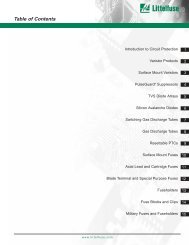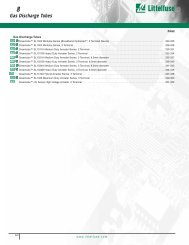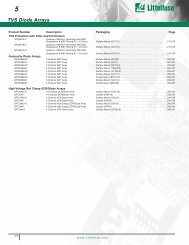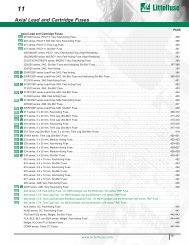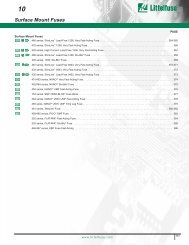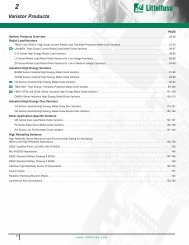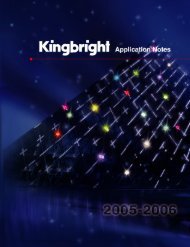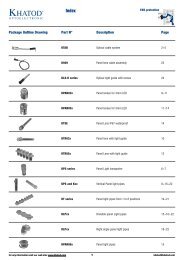ALUMINUM ELECTROLYTIC CAPACITORS
ALUMINUM ELECTROLYTIC CAPACITORS
ALUMINUM ELECTROLYTIC CAPACITORS
Create successful ePaper yourself
Turn your PDF publications into a flip-book with our unique Google optimized e-Paper software.
PRECAUTIONS AND GUIDELINES<br />
For conductive polymer aluminum electrolytic solid capacitors, please refer to PRECAUTIONS AND GUIDELINES (Conductive Polymer)<br />
Designing Device Cir cuits<br />
1 Select the capacitors to suit installation and op er at -<br />
ing con di tions, and use the capacitors to meet the per -<br />
for mance lim its prescribed in this catalog or the prod -<br />
uct spec i fi ca tions.<br />
2<br />
Aluminum Electrolytic Capacitors are polarized.<br />
Apply neither reverse voltage nor AC voltage to po lar ized capac<br />
i tors. Using reversed polarity causes a short cir cuit or venting.<br />
Before use, refer to the cat a log, prod uct spec i fi ca tions or<br />
capacitor body to iden ti fy the po lar i ty marking. (The shape of<br />
rubber seal does not represent the directional rule for polarity.)<br />
Use a bi-po lar type of non-solid alu mi num elec tro lyt ic ca pac i tor<br />
for a cir cuit where the po lar i ty is oc ca sion al ly re versed.<br />
However, note that even a bi-polar aluminum elec tro lyt ic capac<br />
i tor must not be used for AC voltage applications.<br />
3<br />
Do not apply a DC voltage which exceeds the full rat ed volt age.<br />
The peak voltage of a superimposed AC voltage (ripple voltage)<br />
on the DC volt age must not exceed the full rat ed voltage.<br />
A surge voltage value, which exceeds the full rat ed voltage, is<br />
pre scribed in the catalogs, but it is a restricted con di tion, for<br />
especially short periods of time.<br />
4<br />
The rated ripple current has been specifi ed at a certain ripple<br />
fre quen cy. The rated rip ple cur rent at several fre quen cies must<br />
be calculated by mul ti ply ing the rated ripple cur rent at the orig i -<br />
nal frequency using the fre quen cy multipliers for each prod uct<br />
se ries. For more de tails, re fer to the para graph on Alu mi num Electrolytic<br />
Ca pac i tor Life.<br />
5<br />
The use of a capacitor outside the maximum rated category<br />
tem per a ture will considerably shorten the life or cause the capac<br />
i tor to vent.<br />
The relation between the lifetime of aluminum electrolytic capac<br />
i tors and ambient temperature follows Arrhenius’ rule that<br />
the life time is ap prox i mate ly halved with each 10C rise in am bi -<br />
ent tem per a ture.<br />
6<br />
Select the capacitors to meet the service life of a device.<br />
7<br />
Do not use capacitors in circuits where heavy charge and<br />
dis charge cycles are frequently repeated. Frequent and sharp<br />
heavy discharging cycles will result in decreasing ca pac i tance<br />
and damage to the capacitors due to generated heat. Spec i -<br />
fi ed capacitors can be designed to meet the requirements of<br />
charg ing-dis charg ing cy cles, fre quen cy, operating tem per ature,<br />
etc.<br />
8<br />
Polarity<br />
Non-solid aluminum electrolytic capacitors, in general, have a<br />
lifetime which ends in an open circuit, the period is de pen dent<br />
upon temperature. Con se quent ly the life time of ca pac i tors can<br />
be ex tend ed by re duc ing the ambient tem per a ture and/or rip ple<br />
cur rent.<br />
9<br />
Operating voltage<br />
Ripple current<br />
Category temperature<br />
Life expectancy<br />
Charge and discharge<br />
Failure mode of capacitors<br />
Insulating<br />
a) Electrically isolate the following parts of a capacitor from the<br />
neg a tive terminal, the positive terminal and the circuit trac es.<br />
· The outer can case of a non-solid aluminum capacitor.<br />
· The dummy terminal of a non-solid aluminum capacitor,<br />
which is de signed for mounting stability.<br />
(1/10)<br />
b) The outer sleeve of a capacitor is not assured as an in su la -<br />
tor (Except for screw type). For applications that require an<br />
insulated outer sleeve, a cus tom-de sign capacitor is recommended.<br />
10 Condition<br />
Do not use/expose capacitors to the following conditions.<br />
a) Oil, water, salty water storage in damp lo ca tions.<br />
b) Direct sunlight<br />
c) Toxic gases such as hydrogen sulfi de, sulfurous acid, ni trous<br />
acid, chlorine or its compounds, and ammonium<br />
d) Ozone, ultraviolet rays or radiation<br />
e) Severe vibration or mechanical shock conditions beyond<br />
the limits prescribed in the catalogs or the product spec i fi -<br />
ca tion.<br />
11<br />
a) The paper separators and the electrolytic-conductive electro<br />
lytes in a non-solid aluminum electrolytic capacitor are fl amma<br />
ble.<br />
Leaking electrolyte on a printed circuit board can gradually<br />
erode the cop per traces, possibly causing smoke or burn ing<br />
by short-circuiting the cop per trac es.<br />
Verify the following points when designing a PC board.<br />
· Provide the appropriate hole spacing on the PC board to<br />
match the ter mi nal spacing of the capacitor.<br />
· Make the following open space over the vent so that the<br />
vent can op er ate correctly.<br />
Case diameter Clearance<br />
F6.3 to F16mm 2mm minimum<br />
F18 to F35mm 3mm minimum<br />
F40mm and up 5mm minimum<br />
· Do not place any wires or copper traces over the vent of the<br />
capacitor.<br />
· Installing a capacitor with the vent facing the PC board needs<br />
an ap pro pri ate ventilation hole in PC board.<br />
· Do not pass any copper traces beneath the seal side of a<br />
ca pac i tor. The trace must pass 1 or 2mm to the side of the<br />
capacitor.<br />
· Avoid placing any heat-generating objects adjacent to a capac<br />
i tor or even on the reverse side of the PC board.<br />
· Do not pass any via holes underneath a ca pac i tor.<br />
· In designing double-sided PC boards, do not locate any<br />
cop per trace under the seal side of a capacitor.<br />
b) Do not mount the terminal side of a screw mount capacitor<br />
downwards. If a screw terminal capacitor is mounted on its<br />
side, make sure the positive terminal is higher than the neg a -<br />
tive terminal.<br />
Do not tighten the screws of the terminals and the mount ing<br />
clamps over the specifi ed torque prescribed in the cat a log or<br />
the pro duc tion spec i fi ca tion.<br />
c) For a surface mount capacitor, design the copper pads of<br />
the PC board in accordance with the catalog or the prod -<br />
uct spec i fi ca tions.<br />
12<br />
Mounting<br />
Others<br />
a) The electrical characteristics of capacitors vary in re spect<br />
to tem per a ture, frequency and service life. Design the device<br />
cir cuits by tak ing these changes into account.<br />
b) Capacitors mounted in parallel need the current to fl ow<br />
equally through the individual capacitors.<br />
c) Capacitors mounted in series require resistors in parallel<br />
with the in di vid u al capacitors to balance the voltage.<br />
d) Using capacitor for applications which always consider safety.<br />
Consult with our factory before use in applications which<br />
can affect human life.(space equipment, aerial equipment,<br />
nuclear equipment, medical equipment, vehicle control<br />
equipment, etc) Please note that the product, which is<br />
CAT. No. E1001H




